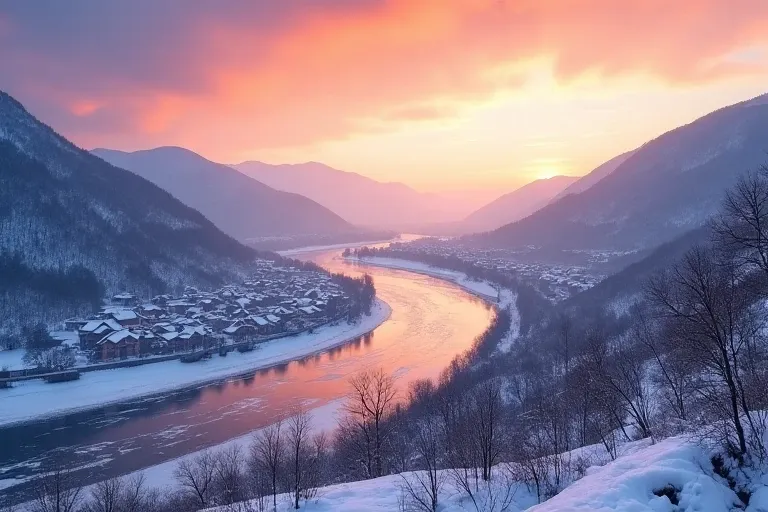Hey everyone, Mark here, your friendly neighborhood American backpacker! I've just returned from an incredible, albeit frigid, journey through Northeast China, and I’m bursting to share my experiences in Mohe, a city so far north it practically kisses the Russian border. My adventure wasn't without its hiccups – blizzards, flight cancellations, and temperatures that would freeze the fillings in your teeth – but trust me, the rewards far outweighed the challenges. This is more than just a travelogue; it's a story of resilience, both human and natural, in a land where winter reigns supreme.
A Treacherous Trek North: The Road to Mohe from Heihe
My epic journey began in Heihe, a charming city bordering Russia, where I spent a surprisingly delightful ten days. Unfortunately, a sudden and rather ferocious blizzard descended, throwing a wrench into my meticulously planned itinerary. Flights and buses ground to a halt, stranding me for a few unexpectedly (and rather chilly) days. However, my spirit remained unyielding. Finally, the skies cleared (somewhat), and I boarded my flight to Mohe, a city shrouded in mystery and anticipation. Heihe Aihun Airport was a surprisingly small affair, a stark contrast to the bustling airports I'm used to. Just three check-in counters and a single gate greeted me, offering a glimpse into the quiet life of this far-flung city. Most visitors arrive by train or bus, the airport seemingly a secondary route for travelers seeking the unique appeal of this northeastern Chinese city. The wait felt long, stretching into the afternoon, but the anticipation was palpable. As we took off, the breathtaking sunset painted the snow-dusted landscape in fiery hues. Rolling hills, blanketed in a pristine layer of snow, stretched out before me, a preview of the icy wonderland that awaited.
Arrival in Mohe: A First Taste of Extreme Cold
Stepping off the plane in Mohe felt like stepping onto another planet. The frigid air bit with a ferocity I hadn’t fully anticipated, even after weeks spent in Northeast China’s cooler climes. The airport sign, a bold proclamation of patriotic sentiment, read "In the Northernmost Place, Heart to the Central Party," a fitting welcome to this remote outpost. A quick glance at the thermometer confirmed my suspicions: a bone-chilling -12°C (-19°C with windchill), a testament to Mohe’s claim as one of China's coldest cities. Even the ice cream shop proudly advertised its latitude: 53° North, a reminder of my proximity to the Arctic Circle.
Mohe's Unique Allure: A Blend of Rustic Charm and Modern Convenience
My first night was spent in a modest room (40 Yuan, roughly $5.50 USD), surprisingly affordable considering the location, though rather basic in its amenities. Two beds, a single window, and no private bathroom were its main features. Yet, the presence of a fan offered a peculiar counterpoint to the extreme cold, hinting at surprisingly warmer summer temperatures. The city, however, presented a quiet, almost deserted feel, particularly at night. This is partially due to the frigid temperatures, but also the decrease in population over the years. The locals confided in me that while the official census lists over 50,000 residents, the actual number is considerably less.
My culinary explorations were just as interesting as the accommodations. I indulged in several local treats: sweet candied haws (5 Yuan, or about $0.70 USD each), and a surprisingly hearty bowl of pork rib rice (24 Yuan, approximately $3.30 USD) which hit the spot after a long day of travel. Dinners were a solitary affair, however. Most restaurants had only a single customer at any one time, a reflection, I was told, of the local custom of "staying in" during the worst of the winter. I even stumbled upon a poignant local story, a tale recounted by a local singer about an elderly woman dancing alone in the Mohe Dance Hall, a silent tribute to her deceased husband. This simple story reflected a powerful aspect of the human spirit in the face of hardship.
Mohe's Scarred Past: The Devastating 1987 Great Fire
Beyond its icy charm, Mohe holds a history as compelling as its landscape. A visit to the Mohe 1987 Great Fire Memorial Hall proved a sobering experience. The memorial hall is a stark reminder of the massive forest fire that ravaged the region from May 6th to June 2nd, 1987. The sheer scale of the disaster, which consumed vast tracts of forest and claimed many lives, is deeply moving. The exhibits showcased the intensity of the fire, the heroic efforts of the firefighters, and the immense loss suffered by the community. The stories of survival, both human and ecological, were especially compelling. Speaking with a local who had witnessed the fire firsthand, I gained a new appreciation of the town's resilience and its enduring spirit. The story of survival and rebuilding following the fire is something I will long remember. This disaster shaped the future of Mohe, and many of the residents of the region.
Everyday Life in Mohe: A Portrait of Adaptability and Resilience
Despite the extreme cold, life persists in Mohe. A visit to the bustling local market revealed the remarkable diversity of produce available – a surprising array of fruits and vegetables, from southern Chinese tangerines to hearty Russian-style bread. This testament to modern logistics and the determination of the locals truly surprised me. A chat with some vendors from Guangxi Province underscored the surprising reach of the market. This wasn't just a collection of locally grown goods, but a reflection of global trade reaching the very edge of the country.
The Challenges of Northern Living: Population Decline and Economic Shifts
Conversations with residents offered a glimpse into the challenges of life in Mohe. The decline in forestry and mining, the traditional economic pillars of the region, has led to a significant decrease in population, with many younger generations seeking opportunities elsewhere. This exodus is a painful reality for Mohe's older residents, many of whom spoke frankly about their plans to move to warmer regions once they retire. This trend is not unique to Mohe, mirroring similar demographic shifts in other northeast Chinese cities. I encountered ingenious adaptations to the harsh climate, from multi-layered doors on houses, designed to prevent heat loss, to the use of snow as a natural insulator. The resourceful spirit of the people here is truly inspirational.
Mohe's Hidden Gems: Exploring Beyond the City's Center
Mohe’s appeal isn't limited to its central areas. I visited the Songyuan Park, a green oasis surprisingly resilient after enduring the 1987 fire. The surprisingly old trees were a striking sight; they were surprisingly old and large, considering the climate and the fire. Each tree, marked with an ID number and age, silently bore witness to decades of harsh winters. I also discovered the ingenious ways that some residents created makeshift ski slopes in their backyards, capitalizing on the abundance of snow.
Final Reflections: A Journey Worth Taking
My trip to Mohe was an experience that transcended mere tourism. The extreme cold was, undeniably, a challenge, but the city's unique spirit, the warmth of its people, and its compelling history made it an immensely rewarding adventure. If you're seeking a unique travel experience, a journey off the well-trodden path, and a glimpse into a world shaped by both human resilience and the power of nature, then Mohe is a place you should absolutely consider. Just remember to pack extra layers!
Table: Prices in Mohe (in Yuan and USD)
| Item | Price (Yuan) | Price (USD, approx.) |
|---|---|---|
| Modest Room | 40 | $5.50 |
| Candied Haws | 5 | $0.70 |
| Hearty Pork Rib Rice | 24 | $3.30 |
| Bottled Water | 3 | $0.40 |
| Eight Treasure Porridge | 4 | $0.55 |
| Small Chicken and Mushroom Stew | 68 | $9.30 |







